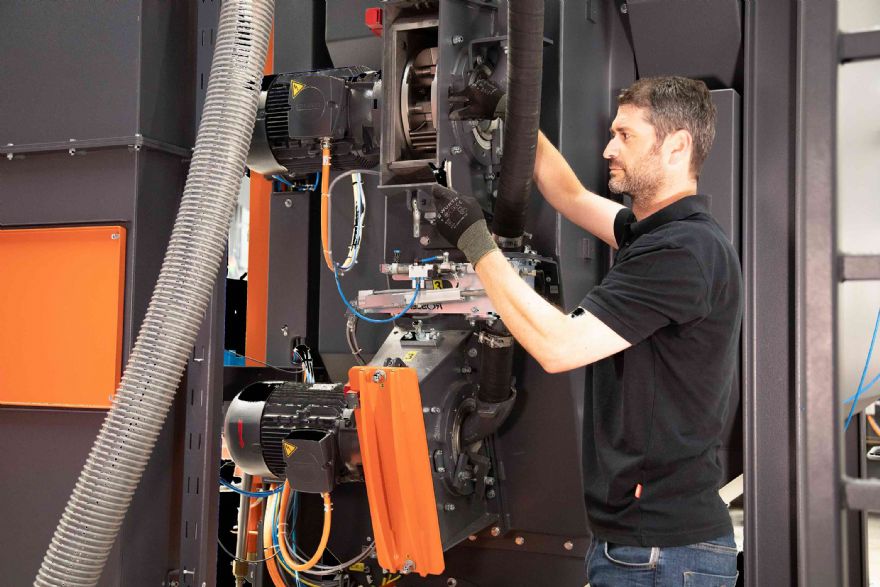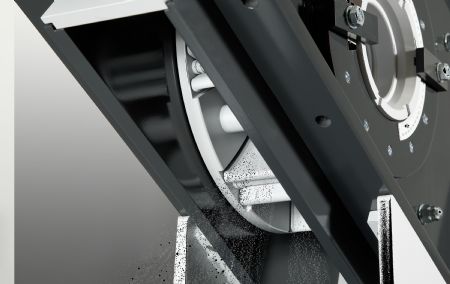
Operational efficiency and cost-effectiveness are key in today’s manufacturing environment. Companies are constantly looking for ways to improve their processes and cut costs. When it comes to shot blasting and mass finishing equipment, businesses often face the decision of investing in new machinery or upgrading their existing systems.
Chris Kershaw, digitalisation and automation manager (service) at
Rösler UK says that Rösler’s Retrofit and TuneUp service offers a practical and cost-effective alternative, enabling businesses to enhance performance, increase productivity, free-up valuable labour for other key functions, and future-proof their operations.
Rösler Retrofit and TuneUp service is a comprehensive upgrade programme aimed at improving the performance, efficiency, and longevity of existing shot blasting and mass finishing systems. The process begins with a thorough inspection of the equipment and an evaluation of the production process. This assessment is followed by in-depth consultations with the customer to identify enhancements tailored to their specific operational needs.
While the latest shot blasting and finishing technologies offer significant advancements, many of these innovations can be integrated into existing machinery. Retrofitting provides several advantages over purchasing new equipment. One of the most significant benefits is cost savings, as retrofitting often costs significantly less than acquiring new equipment. According to Mr Kershaw, “If significant savings can be made while improving the existing machine, this can be highly beneficial for our customers.”
Minimised disruptionAnother advantage is minimised disruption, as replacing large shot blasting installations can be costly and disruptive. Retrofitting allows companies to modernise their equipment without significant downtime. Many older machines still in operation can benefit from control system enhancements, such as replacing outdated PLCs and HMIs with modern alternatives that improve usability and reliability. Additionally, retrofitting contributes to environmental sustainability by extending the lifespan of existing equipment, reducing waste, and lowering energy consumption.

Pictured left:
IMG shotblasting turbineOne of the major benefits of retrofitting is cost efficiency. Many companies find that upgrading key components extends the lifespan of their machinery, making it a more financially viable solution. Enhanced performance is another significant advantage, as advanced blast wheels and modern control systems can greatly boost equipment productivity. Rösler's Gamma blast wheels, for example, provide energy savings of between 10% and 25% while increasing blasting performance by up to 77%, and reducing cycle times.
Retrofitting also reduces downtime and maintenance costs. Obsolete components can be a major source of unexpected breakdowns, but modernising control systems and upgrading core components significantly enhance reliability. Furthermore, improved energy efficiency and sustainability lower operational costs while supporting sustainable manufacturing goals. As Mr Kershaw explained: “By bringing equipment up to modern standards, increased availability can be achieved.”
Rösler’s retrofit services cater to a wide range of industries, particularly those where high operator workloads, repetitive tasks, and energy consumption are concerns. Automotive manufacturing benefits from automation and control system improvements that enhance precision and consistency. The aerospace industry requires advanced shot blasting for high-quality surface finishes on critical components. Foundries and heavy manufacturing operations, which use large-scale machinery that can be expensive to replace, find retrofitting a more practical choice. Mr Kershaw said: “Rösler machines are used in a wide variety of manufacturing sectors, and we can provide improvements in all of them, especially where there is high operator workload and high levels of repetitivity.”
Initial consultationEngaging with Rösler UK's retrofit service follows a structured approach. The process begins with an initial consultation, during which clients either approach regional sales managers or contact Rösler directly to discuss potential retrofitting options. This is followed by a site evaluation, where a Rösler expert assesses the equipment condition and determines the feasibility of retrofitting. Based on the evaluation, a customised proposal is presented, outlining potential upgrades, expected benefits, and a return on investment analysis.
Not all machines are ideal candidates for retrofitting. Several factors influence this decision, including the overall condition of the equipment. If a machine is in poor condition, a full replacement may be the better option. The availability of replacement components is another consideration, as some obsolete parts may be difficult to source, making retrofitting less viable. Finally, the potential for performance gains plays a crucial role. If significant enhancements can be achieved, retrofitting becomes an attractive and practical solution.
Retrofitting often involves several key technological upgrades. One of the most impactful improvements is blast wheel enhancement, where outdated blast wheels are replaced with high-performance models like the Gamma series, which improve energy efficiency and processing speeds. Control system modernisation is another critical upgrade, with modern PLCs and HMIs enhancing usability and reducing the risks associated with obsolete components.
Enhancing efficiencyThe integration of automation into existing systems is increasingly popular, as it minimises manual intervention, enhances efficiency, and allows skilled labour to be used in other key functions. Mr Kershaw explained: “The most common upgrades are blast wheel and electrical/control upgrades, bringing efficiency, energy, and maintenance savings, and reducing the risk of extended downtime due to obsolete parts.”
A notable case study highlights the significant impact of retrofitting. A manufacturing client operating a shot blasting production cell required modernisation to match the specifications of a new robotic automated system. Previously, the equipment required four operators per machine per week. After the retrofit, automation improvements reduced the need for manual operation to just one operator per shift, cutting production costs per part by 75-80%. The expected return on investment was projected within 12-18 months.
Recognising that capital investment decisions require justification, Rösler offers financing options in partnership with financial institutions. Mr Kershaw added: “We can provide calculations showing the expected savings and increased productivity, demonstrating the benefits and return on investment.”
For manufacturers seeking to enhance the performance of their shot blasting and mass finishing equipment without the high costs and disruptions of purchasing new machines, Rösler Retrofit and TuneUp service presents a compelling alternative. With benefits ranging from cost savings and improved efficiency to sustainability and reduced downtime, retrofitting is an intelligent investment in the future of manufacturing.
Mr Kershaw concluded: “Our goal is to help customers maximise the value of their existing equipment, ensuring they achieve the highest levels of productivity and efficiency in their operations.”